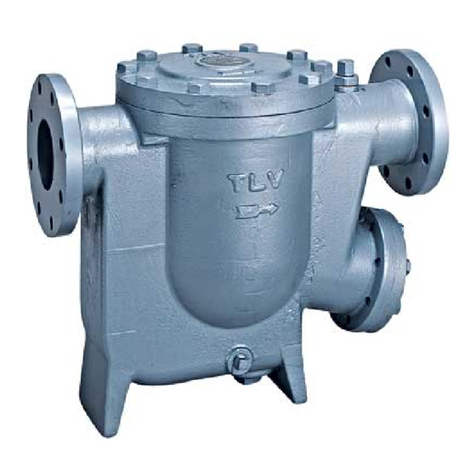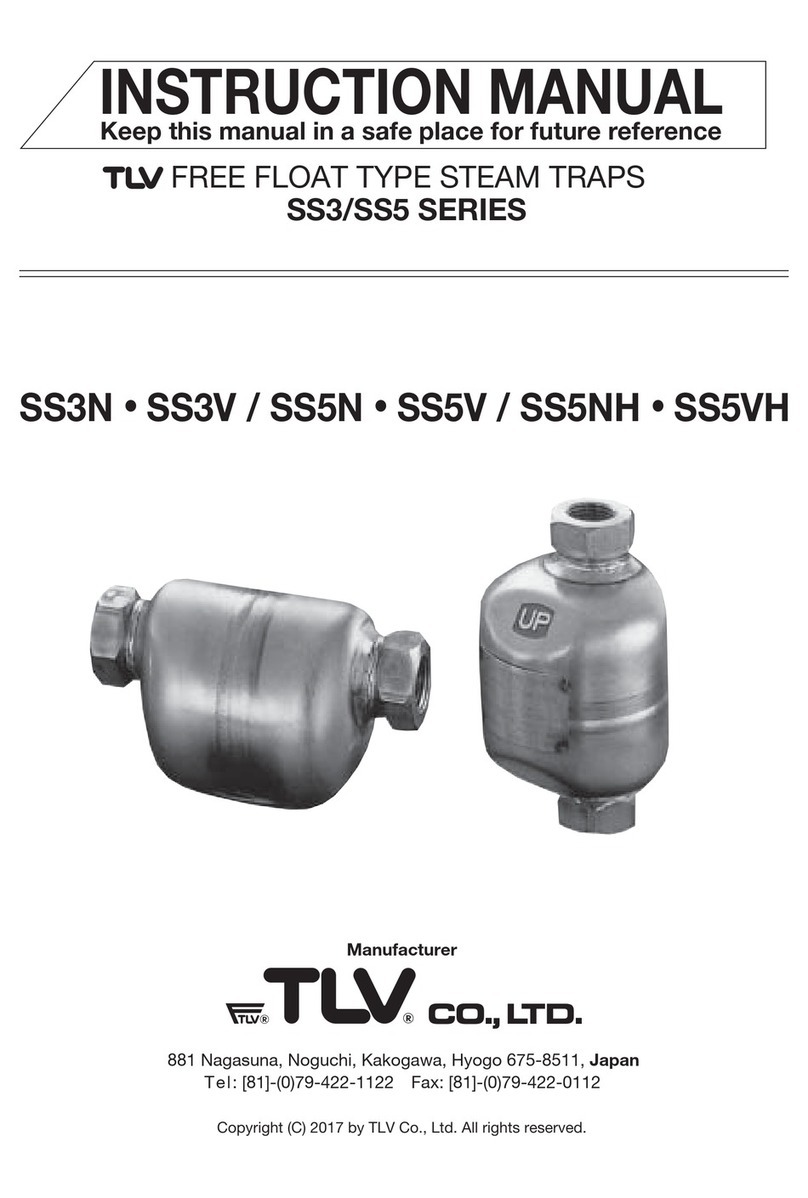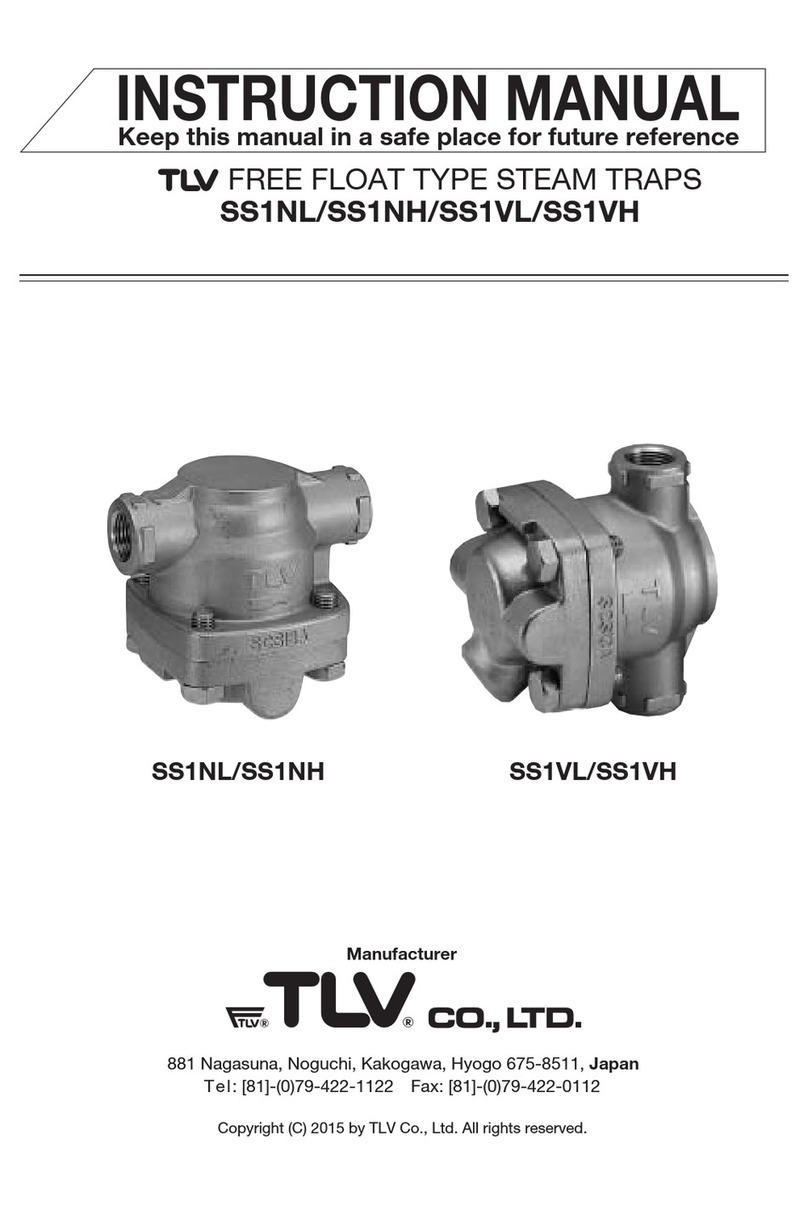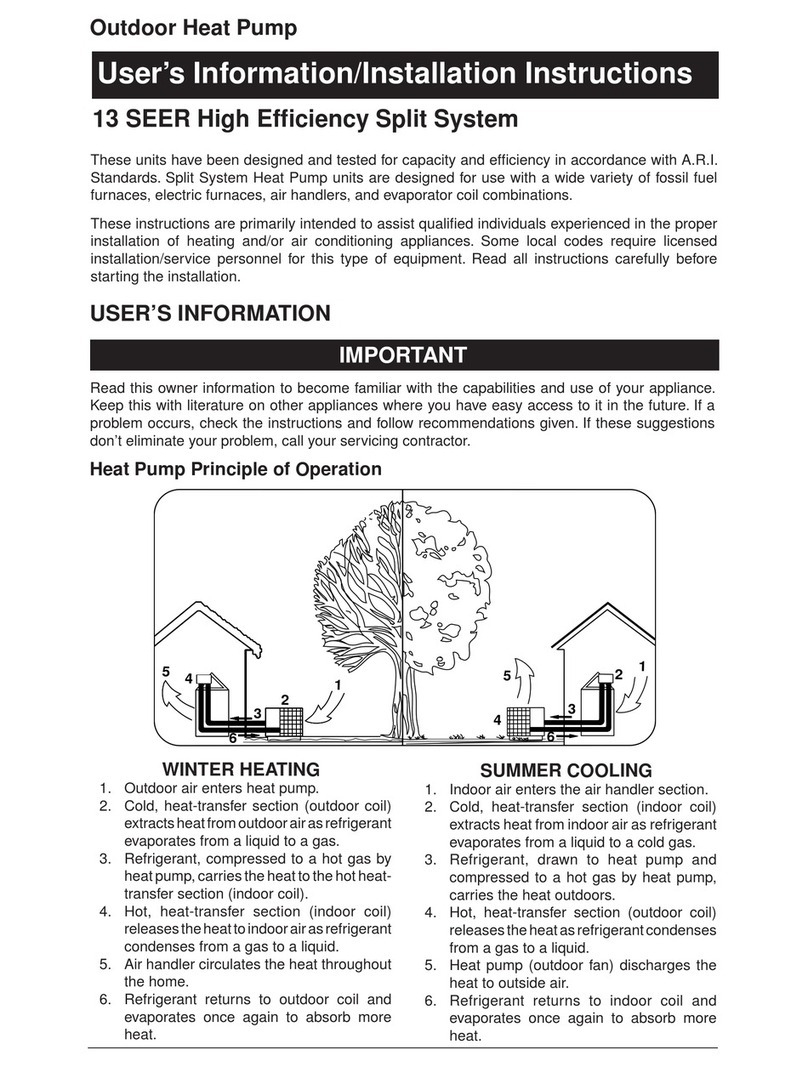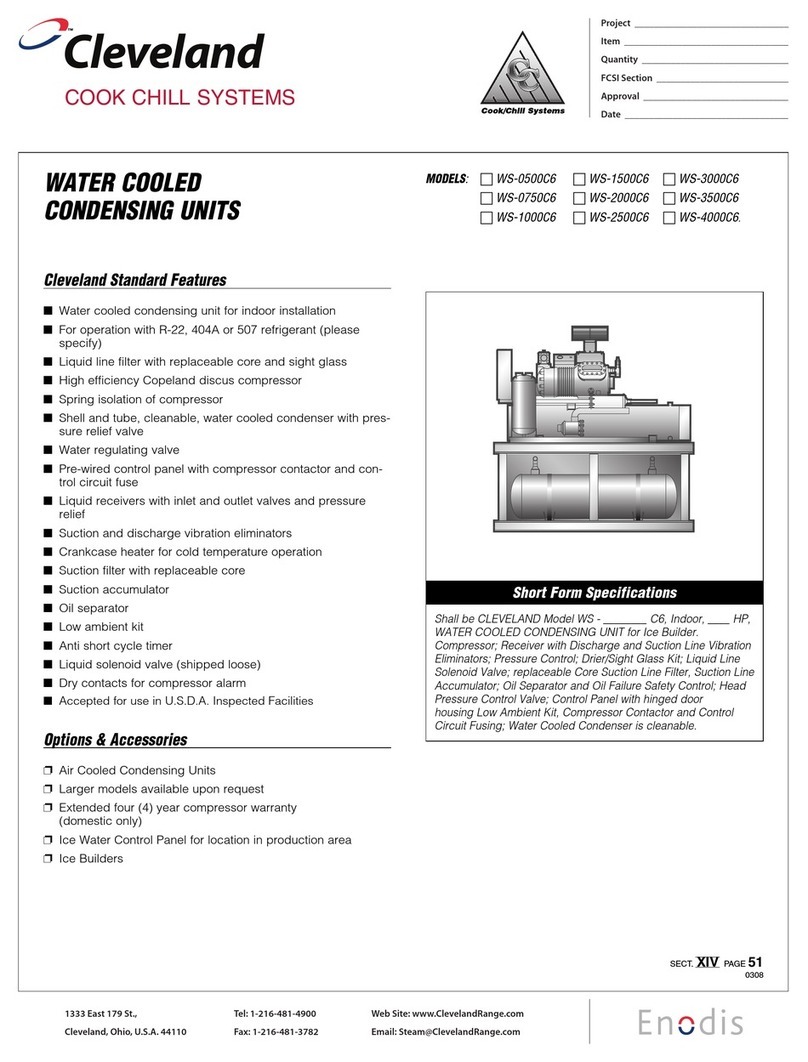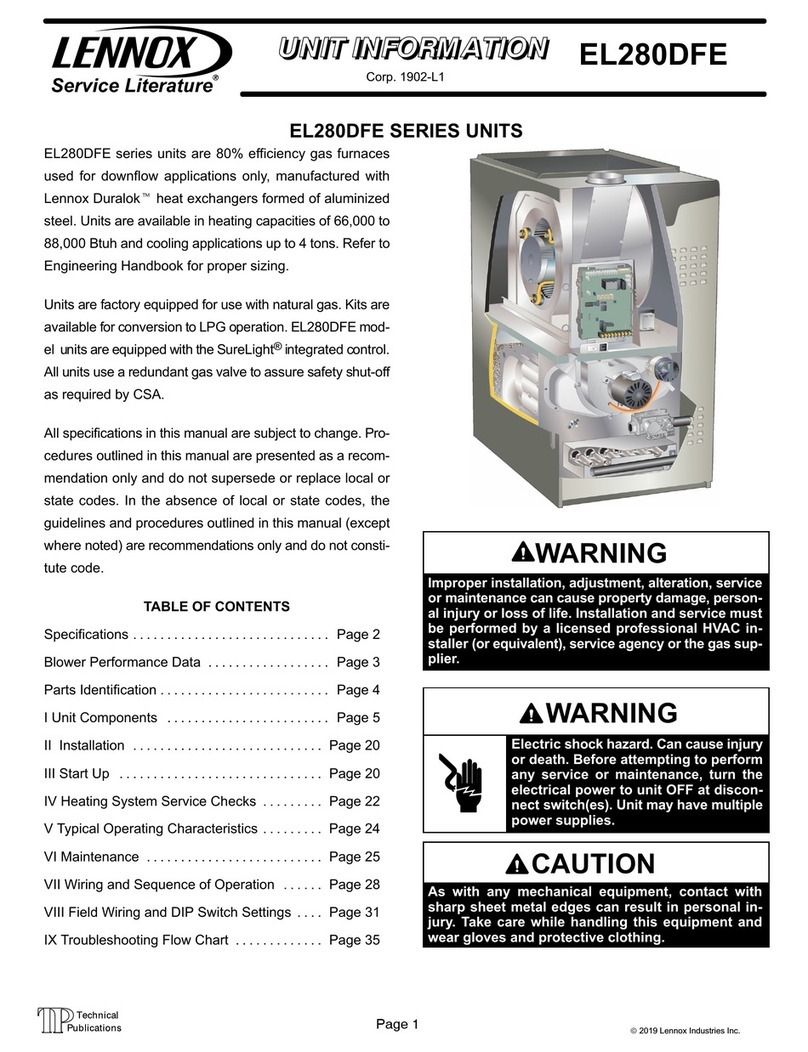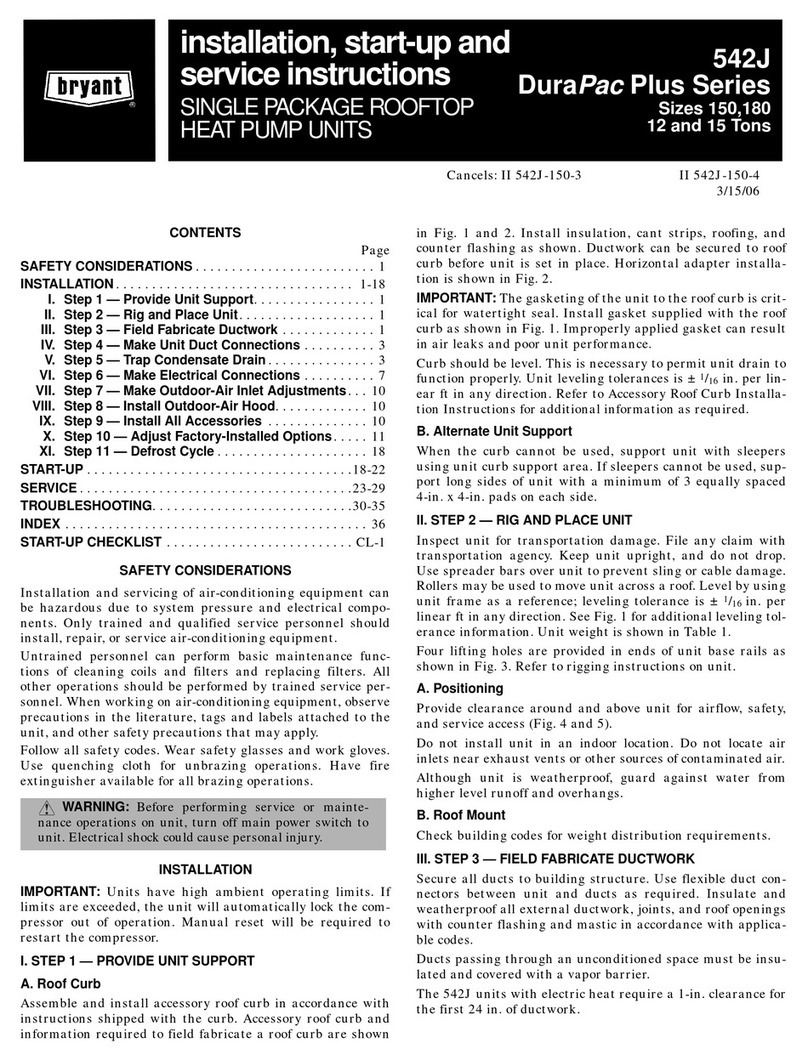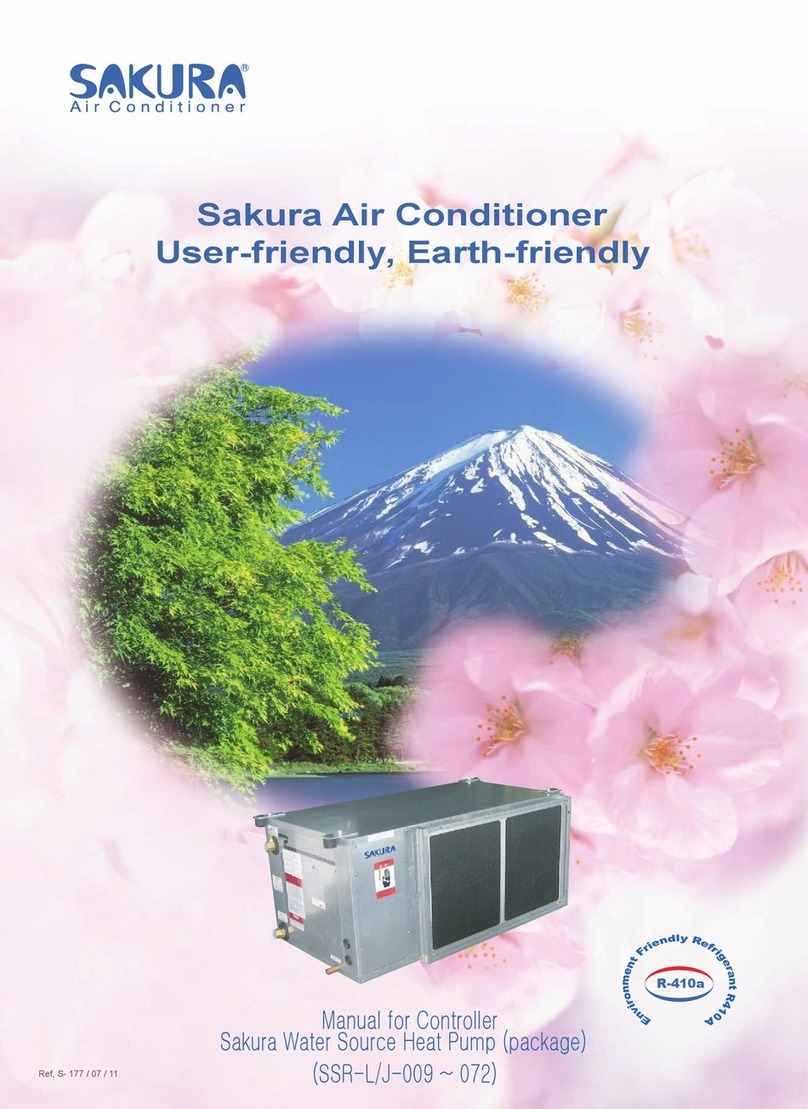TLV L Series User manual

BALANCED PRESSURE THERMOSTATIC
STEAM TRAPS L SERIES
THERMISCHE KAPSEL-KONDENSAT-
ABLEITER L SERIE
PURGEURS DE VAPEUR THERMOSTATIQUES
ÀPRESSION ÉQUILIBRÉE GAMME L
L21S L32S
L21SC L32SC
Copyright (C) 2014by TLV Co., Ltd. All rights reserved.
Deutsch
Français
English
INSTRUCTION MANUAL
Keep this manual in a safe place for future reference
EINBAU- UND BETRIEBSANLEITUNG
Gebrauchsanleitung leicht zugänglich aufbewahren
MANUEL D UTILISATION
Conserver ce manuel dans un endroit facile d'accès
Option
BD2
( )

Before you begin please read this manual to ensure correct usage of the product.
Please keep it in a safe place for future reference.
The L Series steam traps L21S, L32S and L21SC, L32SC with check valve can be used without
adjustment for medium capacity applications and pressures up to 2.1, or 3.2 MPaG (300 or 450
psig). These models are suitable for steam-using equipment that discharges condensate at
temperatures slightly below saturation temperature, such as tracer lines and light process equipment.
1 MPa = 10.197 kg/cm2, 1 bar = 0.1 MPa
For products with special specifications or with options not included in this manual, contact TLV
for instructions.
The contents of this manual are subject to change without notice.
―1―
English
Bitte lesen Sie die Betriebsanleitung vor Einbau und lnbetriebnahme sorgfältig durch und
bewahren Sie sie für späteren Gebrauch an einem leicht zugänglichen Ort auf, um einen
einwandfreien Betrieb des Kondensatableiters (KA) sicherzustellen.
Die thermischen Kondensatableiter der L Serie, L21S, L32S, und L21SC, L32SC mit
Rückschlagventil können ohne besondere Druckeinstellung für mittlere Durchsatzleistungen und
Betriebsdrücke bis 21 bzw. 32 bar ü eingesetzt werden. Sie eignen sich besonders für Anwendungen,
bei denen Kondensat mit geringer Unterkühlung unter Sattdampftemperatur abgeleitet werden
soll, insbesondere zur Leitungsentwässerung, für Begleitheizungen, sowie kleinere Trocken- und
Heizeinrichtungen.
1 bar = 0,1 MPa
Wenden Sie sich an TLV für Sonderausführungen, die nicht in dieser Einbau- und Betriebs-
anleitung enthalten sind.
Wir behalten uns vor, den Inhalt dieser Betriebsanleitung ohne Ankündigung zu ändern.
Einführung
Deutsch
Français
Veuillez lire attentivement ce manuel afin d’utiliser correctement le produit.
Nous vous recommandons de le garder dans un endroit sûr pour de futures références.
Les purgeurs de vapeur de la gamme L, L21S, L32S et L21SC, L32SC avec clapet de retenue
peuvent être utilisés sans ajustement sur des applications de capacité moyenne, jusqu'à 21 ou
32 bar. Ces modèles conviennent aux installations de chauffage évacuant le condensât à une
température légèrement inférieure à la température de saturation, telles les conduites et tubulures
de vapeur, les lignes de traçage et les petites installations utilisant de la vapeur.
1 bar = 0,1 MPa
Pour tout produit aux spécifications particulières ou comportant des options non reprises dans ce
manuel, veuillez contacter TLV.
Le contenu de ce manuel est sujet à modifications sans préavis.
Introduction
Introduction

―2―
EnglishEnglish
1. Safety Considerations
• Read this section carefully before use and be sure to follow the instructions.
• Installation, inspection, maintenance, repairs, disassembly, adjustment and valve
opening/closing should be carried out only by trained maintenance personnel.
• The precautions listed in this manual are designed to ensure safety and prevent equipment
damage and personal injury. For situations that may occur as a result of erroneous handling,
three different types of cautionary items are used to indicate the degree of urgency and the
scale of potential damage and danger: DANGER, WARNING and CAUTION.
• The three types of cautionary items above are very important for safety; be sure to observe
all of them, as they relate to installation, use, maintenance, and repair. Furthermore, TLV
accepts no responsibility for any accidents or damage occurring as a result of failure to
observe these precautions.
Indicates an urgent situation that poses a threat of death or serious injury.
Indicates a DANGER, WARNING or CAUTION item.
Indicates that there is a potential threat of death or serious injury.
CAUTION
WARNING
DANGER
CAUTION Indicates that there is a possibility of injury, or equipment/product
damage.
Install properly and DO NOT use this product outside the recommended
operating pressure, temperature and other specification ranges.
Improper use may result in such hazards as damage to the product or
malfunctions, which may lead to serious accidents. Local regulations may
restrict the use of this product to below the conditions quoted.
Take measures to prevent people from coming into direct contact
with product outlets. Failure to do so may result in burns or other injury
from the discharge of fluids.
Do not use excessive force when connecting threaded pipes to the
product. Over-tightening may cause breakage leading to fluid discharge,
which may cause burns or other injury.
When disassembling or removing the product, wait until the internal
pressure equals atmospheric pressure and the surface of the
product has cooled to room temperature. Disassembling or removing
the product when it is hot or under pressure may lead to discharge of
fluids, causing burns, other injuries or damage.
Be sure to use only the recommended components when repairing
the product, and NEVER attempt to modify the product in any way.
Failure to observe these precautions may result in damage to the product
or burns or other injury due to malfunction or the discharge of fluids.
Use only under conditions in which no freeze-up will occur. Freezing
may damage the product, leading to fluid discharge, which may cause
burns or other injury.
Use under conditions in which no water hammer will occur. The
impact of water hammer may damage the product, leading to fluid
discharge, which may cause burns or other injury.
Do not subject the trap to condensate loads that exceed its
discharge capacity. Failure to observe this precaution may lead to
condensate accumulation upstream of the trap, resulting in reduced
equipment performance or damage to the equipment.

―3―
Deutsch
1. Sicherheitshinweise
• Bitte lesen Sie dieses Kapitel vor Beginn der Arbeiten sorgfältig durch und befolgen Sie die
Vorschriften.
• Einbau und Ausbau, Inspektion, Wartungs- und Reparaturarbeiten, Öffnen/Schließen von
Armaturen, Einstellung von Komponenten, dürfen nur von geschultem Wartungspersonal
vorgenommen werden.
• Die Sicherheitshinweise in dieser Einbau- und Betriebsanleitung dienen dazu, Unfälle,
Verletzungen, Betriebsstörungen und Beschädigungen der Anlagen zu vermeiden. Für
Gefahrensituationen, die durch falsches Handeln entstehen können, werden drei verschiedene
Warnzeichen benutzt: GEFAHR; WARNUNG; VORSICHT.
• Diese drei Warnzeichen sind wichtig für Ihre Sicherheit. Sie müssen unbedingt beachtet
werden, um den sicheren Gebrauch des Produktes zu gewährleisten und Einbau, Wartung und
Reparatur ohne Unfälle oder Schäden durchführen zu können. TLV haftet nicht für Unfälle oder
Schäden, die durch Nichtbeachtung dieser Sicherheitshinweise entstehen.
Dieses Zeichen weist auf GEFAHR; WARNUNG; VORSICHT hin.
VORSICHT
Die Einbauhinweise beachten und die spezifizierten Betriebsgrenzen
NICHT ÜBERSCHREITEN. Nichtbeachtung kann zu Betriebsstörungen
oder Unfällen führen. Lokale Vorschriften können zur Unterschreitung der
angegebenen Werte zwingen.
In sicherer Entfernung von Auslassöffnungen aufhalten und andere
Personen warnen, sich fernzuhalten. Nichtbeachtung kann zu
Verletzungen durch austretende Fluide führen.
Vor Öffnen des Gehäuses und Ausbau von Teilen warten, bis der
Innendruck sich auf Atmosphärendruck gesenkt hat und das
Gehäuse auf Raumtemperatur abgekühlt ist. Nichtbeachtung kann zu
Verbrennungen oder Verletzungen durch austretende Fluide führen.
Zur Reparatur nur Original-Ersatzteile verwenden und NICHT
VERSUCHEN, das Produkt zu verändern. Nichtbeachtung kann zu
Beschädigungen führen, die Betriebsstörungen, Verbrennungen oder
andere Verletzungen durch austretende Fluide verursachen.
Bei Schraubanschlüssen keine übermäßige Kraft anwenden, damit
die Gewinde nicht beschädigt werden, was zu Verbrennungen oder
Verletzungen durch austretende Fluide führt.
Nur in frostsicherer Umgebung einsetzen. Einfrieren kann das Produkt
beschädigen, was zu Verbrennungen oder Verletzungen durch
austretende Fluide führt.
Nur an Stellen einbauen, an denen kein Wasserschlag eintreten
kann. Wasserschlag kann das Produkt beschädigen und zu
Verbrennungen oder Verletzungen durch austretende Fluide führen.
bedeutet, dass eine unmittelbare Gefahr für Leib und Leben besteht.
bedeutet, dass die Möglichkeit der Gefahr für Leib und Leben besteht.
WARNUNG
GEFAHR
VORSICHT
bedeutet dass die Möglichkeit von Verletzungen oder Schäden an
Anlagen oder Produkten besteht.
Das Produkt nicht bei Durchsatzmengen über der Nenn-
durchsatzleistung betreiben. Nichtbeachtung kann zu Kondensatrück-
stau führen wodurch die Leistung der Anlage beeinträchtigt, oder deren
Beschädigung verursacht wird.

1. Règles de sécurité
• Lire attentivement cette notice avant l’utilisation et suivre les instructions.
• Tout installation, inspection, entretien, réparation, démontage, ajustement et
ouverture/fermeture de vanne doit être fait uniquement par une personne formée à l’entretien.
• La liste des précautions à prendre est établie afin d’assurer votre sécurité et de prévenir des
dégâts matériels et/ou des blessures sérieuses. Dans certaines situations causées par une
mauvaise manipulation, trois indicateurs sont utilisés afin d’indiquer le degré d’urgence,
l’échelle du dommage potentiel et le danger: DANGER, AVERTISSEMENT et ATTENTION.
• Ces 3 indicateurs sont importants pour votre sécurité; observez les précautions de sécurité
énumérées dans ce manuel pour l’installation, l’utilisation, l'entretien et la réparation du produit.
TLV n’accepte aucune responsabilité en cas d’accident ou de dommage survenant à la suite
d'un non-respect de ces précautions.
Indique une situation d’urgence avec risque de mort ou de blessure grave.
Indique un DANGER, un AVERTISSEMENT ou recommande une ATTENTION.
Indique une situation pouvant entraîner la mort ou des blessures graves.
ATTENTION
AVERTISSEMENT
DANGER
ATTENTION
Indique un risque de blessure ou de dégât matériel au produit et/ou aux
installations.
Installer le produit correctement et NE PAS l’utiliser en dehors de la
pression et de la température maximales de fonctionnement, ni en
dehors des autres plages spécifiées. Une telle utilisation peut entraîner
des dommages au produit ou des dysfonctionnements, ce qui peut
provoquer des brûlures ou autres blessures. Il se peut que des règlements
locaux limitent l'utilisation du produit en-deçà des spécifications indiquées.
Prendre les mesures appropriées afin d’éviter que des personnes
n’entrent en contact direct avec les ouvertures du produit. Le non-
respect de cette règle peut provoquer des brûlures ou autres blessures
sérieuses dues à l’écoulement des fluides.
Ne pas utiliser de force excessive lors de la connexion du produit à
la tuyauterie. Le non-respect de cette règle peut provoquer la rupture
du produit et mener a l’écoulement des fluides, causant des brûlures ou
blessures sérieuses.
En cas de démontage ou de manipulation du produit, attendre que
la pression interne soit égale à la pression atmosphérique et que la
surface du produit soit complètement refroidie. Le non-respect de
cette règle peut provoquer des brûlures ou autres dommages dûs à
l’écoulement des fluides.
En cas de réparation, utiliser uniquement les composants
spécifiques du produit et NE JAMAIS ESSAYER de modifier le
produit. Le non-respect de cette règle peut entraîner des dommages au
produit, ou des brûlures et autres blessures sérieuses dues au
dysfonctionnement du produit ou à l’écoulement des fluides.
N'utiliser que dans des conditions où le gel ne se produit pas. Le gel
peut endommager le produit et provoquer l’écoulement des fluides, et
causer des brûlures ou autres blessures sérieuses.
Utiliser le produit dans des conditions où il n’y a aucun coup de
bélier. L’impact d'un coup de bélier peut endommager le produit et
provoquer l’écoulement des fluides, ainsi que des brûlures ou des
blessures graves.
Ne pas soumettre le purgeur à des charges de condensât
supérieures à sa capacité d'expulsion. Le non-respect de cette consigne
peut engendrer une accumulation de condensât en amont du purgeur et
réduire les performances des installations, voire les endommager.
―4―
Français

2.
Specifications Technische Daten Données techniques
Refer to the product nameplate for detailed specifications.
Die technischen Daten stehen auf dem Typenschild.
Les données techniques sont inscrites sur la plaquette nominative.
* Maximum allowable pressure (PMA) and maximum allowable temperature (TMA) are
PRESSURE SHELL DESIGN CONDITIONS, NOT OPERATING CONDITIONS.
** "Valve No." is displayed for products with options. This item is omitted from the
nameplate when there are no options.
* Maximal zulässiger Druck (PMA) und maximal zulässige Temperatur (TMA) sind
AUSLEGUNGSDATEN, NICHT BETRIEBSDATEN.
** Die "Valve No." wird angegeben bei Typen mit Optionen. Bei Typen ohne Optionen bleibt
diese Stelle frei.
* Pression maximale admissible (PMA) et température maximale admissible (TMA) sont les
CONDITIONS CONCEPTION, PAS LES CONDITIONS DE FONCTIONNEMENT.
** Le "Valve No." est indiqué sur les modèles avec options. Ce numéro ne figure pas sur les
modèles sans options.
G Serial Number
Seriennummer
Numéro de série
H Valve No.**
I Type of X-element
X-Element-Typ
Type d'élément X
C Maximum Allowable Pressure*
Maximal zulässiger Druck*
Pression maximale admissible*
F Maximum Operating Temperature TMO
Maximale Betriebstemperatur TMO
Température de fonctionnement maximale TMO
D Maximum Allowable Temperature* TMA
Maximal zulässige Temperatur* TMA
Température maximale admissible* TMA
A Model
Typ
Modèle
E Maximum Operating Pressure
Maximaler Betriebsdruck
Pression de fonctionnement maximale
B Nominal Diameter
Größe/DN
Dimension/DN
A
D
I
F
G
C
B
E
H
Die Einbauhinweise beachten und die spezifizierten Betriebsgrenzen
NICHT ÜBERSCHREITEN. Nichtbeachtung kann zu Betriebsstörungen
oder Unfällen führen. Lokale Vorschriften können zur Unterschreitung der
angegebenen Werte zwingen.
VORSICHT
Installer le produit correctement et NE PAS l’utiliser en dehors des plages
spécifiées. En cas de dépassement des limites données, des dysfonc-
tionnements ou accidents pourraient survenir. Il se peut que des
règlements locaux limitent l'utilisation du produit en-deçà des
spécifications indiquées.
ATTENTION
To avoid malfunctions, product damage, accidents or serious injury,
install properly and DO NOT use this product outside the specification
range. Local regulations may restrict the use of this product to below the
conditions quoted.
CAUTION
―5―
English
Deutsch
Français

―6―
2.1 Maximum Operating Temperature
2.1 Maximale Betriebstemperatur
100
150
200
220
250
05 21 3210 15 20 25 30
Betriebsdruck (bar ü)
235˚C 240˚C
Sattdampfkurve
Temperatur ˚C
L21S(C)
L32S(C)
2.1 Température de fonctionnement maximale
100
150
200
220
250
05 21 3210 15 20 25 30
Pression (bar)
235˚C 240˚C
Courbe de saturation de la vapeur
Température ˚C
L21S(C)
L32S(C)
Deutsch
Français
English
100
150
200
(428˚F)
220
250
212
302
392
482
0 0.5
(75) 2.1
(300) 3.2
(450)
1.0
(150) 1.5
(215) 2.0 2.5
(350) 3.0
Pressure MPaG (psig)
235˚C
455˚F
240˚C
464˚F
Saturated Steam Curve
Temperature ˚F
Temperature ˚C
L21S(C)
L32S(C)
1 MPaG = 10.197 kg/cm2

3. Configuration Aufbau Configuration
―7―
Description
i
o
u
q
t
r
e
w
!1
!2
!0
y
No.
1
2
3
4
5
6
7
8
9
10
11
12
13
14
Body
Cover
X-element
Screen
Screen Holder Gasket
Screen Holder
Valve Seat
X-element Guide
Spring Clip
Cover Gasket
Cover Bolt
Nameplate
Flange (not shown)
Check Valve Ball
Désignation
No.
1
2
3
4
5
6
7
8
9
10
11
12
13
14
Corps
Couvercle
Elément X
Crépine
Joint porte-crépine
Bouchon porte-crépine
Siège de soupape
Guide de l’élément X
Menotte de ressort
Joint de couvercle
Boulon de couvercle
Plaquette nominative
Bride (non illustré)
Boule clapet de retenue
Bauteil
Nr.
1
2
3
4
5
6
7
8
9
10
11
12
13
14
Gehäuse
Gehäusedeckel
X-Element
Schmutzsieb
Siebstopfendichtung
Siebhaltestopfen
Ventilsitz
X-Element-Halterung
Spannbügel
Gehäusedichtung
Gehäuseschraube
Typenschild
Flansch (nicht gezeigt)
Rückschlagventilkugel
!4
M
*
R
*
W
*
R
*
E*
R
*
Check valve type
Mit Rückschlagventil
Avec clapet de retenue
English
Deutsch
Français
* Maintenance Parts and Repair Parts:
(M) Maintenance Kit, (R) Repair Kit. Replacement parts are
available only in their respective kits.
* Ersatzteile für Wartung und Reparatur:
(W) Wartungssatz, (R) Reparatursatz. Ersatzteile werden nicht
einzeln, sondern als Teil dieser beiden Einheiten geliefert.
* Pièces d'entretien et de réparation:
(E) Jeu de pièces d'entretien, (R) Jeu de pièces de
réparation. Les pièces de remplacement ne sont disponibles
que sous la forme de jeux de pièces.
L21S / L32S
L21SC / L32SC

Deutsch
Français
English
―8―
With check valve
Mit Rückschlagventil
Avec clapet de retenue
4.
Exploded View Einzelteile Pièces détachées
12 Nameplate
Typenschild
Plaquette nominative
11 Cover Bolt
Gehäuseschraube
Boulon de couvercle
9 Spring Clip
Spannbügel
Menotte de ressort
3 X-element
X-Element
Elément X
2 Cover
Gehäusedeckel
Couvercle
10 Cover Gasket
Gehäusedichtung
Joint de couvercle
4 Screen
Schmutzsieb
Crépine
5 Screen Holder Gasket
Siebstopfendichtung
Joint de bouchon
6 Screen Holder
Siebhaltestopfen
Bouchon porte-crépine
7 Valve Seat
Ventilsitz
Siège de soupape
8 X-element Guide
X-Element Halterung
Guide élément X
1 Body
Gehäuse
Corps
14 Check valve ball
Rückschlagventilkugel
Boule clapet de retenue
Part & No.
Tightening Torque and Distance Across Flats
Cover Bolt 11
Valve Seat 7
Screen Holder 6
N·m (lbf·ft)
35 (25)
35 (25)
60 (43)
mm (in)
13 ( )
19 ( )
22 ( )
2
1
/
1 N・m ~
~10 kg·cm
Bauteil & Nr.
Anzugsmoment und Schlüsselweite
Gehäuseschraube 11
Ventilsitz 7
Siebhaltestopfen 6
mm
13
19
22
N·m
35
35
60
Pièce & No.
Moments de torsion et ouvertures de clé
Boulon de couvercle 11
Siège de soupape 7
Bouchon porte-crépine 6
mm
13
19
22
N·m
35
35
60
8
7
/
4
3
/
If drawings or other special documentation were supplied for the product, any torque given there
takes precedence over values shown here.
Falls Zeichnungen oder andere spezielle Dokumente mit dem Produkt geliefert wurden,
haben Angaben über Anzugsmomente in diesen Unterlagen Vorrang vor den hier gezeigten
Anzugsmomenten.
Si des dessins ou autres documents spéciaux ont été fournis pour le produit, les moments
de torsion donnés dans ces documents doivent être pris en compte plutôt que les valeurs
données ici.

―9―
English
NOTE: For socket weld connections, use electric arc welding with a single pass. As internal parts
are not damaged by one-pass welding there is no need to remove them before welding.
1. Horizontal installation (nameplate showing up) is recommended, vertical installation is possible.
The arrow on the trap must point in the direction of flow. DO NOT install trap on its side or
upside down.
2. Before installing the steam trap, blow out the inlet piping to remove all dirt and oil.
3. Install a bypass valve, and inlet and outlet valves for maintenance or trap failure situations.
4. Install the trap in the lowest part of the pipeline or equipment so the condensate flows into the
trap by gravity. The inlet pipe should be as short and have as few bends as possible.
5. Install a check valve at the trap outlet of L21S, L32S whenever the condensate discharge pipe
leads to a tank or recovery line; or whenever the condensate collection pipeline is connected to
more than one trap.
6. Support the pipes within 0.8 meters (2.5 ft) on either side of the trap.
7. In order to avoid excessive back pressure (the outlet back pressure should be no more than
90% of the inlet steam pressure), make sure the discharge pipes are large enough;
8. The use of unions is recommended to facilitate connection of the screwed version.
6. Piping Arrangement
5. Proper Installation
• Installation, inspection, maintenance, repairs, disassembly, adjustment
and valve opening/closing should be carried out only by trained
maintenance personnel.
• Take measures to prevent people from coming into direct contact with
product outlets.
• Do not use excessive force when connecting threaded pipes.
• Install for use under conditions in which no freeze-up will occur.
• Install for use under conditions in which no water hammer will occur.
CAUTION
Requirement
Diameter is too small.
Diameter is too small
and inlet protrudes
into pipe.
Rust and scale flow
into the trap with the
condensate.
Condensate collects
in the pipe.
Correct Incorrect
Install a catchpot of the
proper diameter.
Make sure the flow of
condensate is not
obstructed.
To prevent rust and scale
from flowing into the trap,
connect the inlet pipe 25 -
50 mm (1 - 2 in) above the
base of the T - pipe.
When installing on the blind
end, make sure nothing
obstructs the flow of
condensate.
continued on page 10

―10―
EnglishEnglish
Check to make sure that the pipes connected to the trap have been installed properly.
1. Is the pipe diameter suitable?
2. Has the trap been installed with the arrow on the body pointing in the direction of flow?
3. Has sufficient space been secured for maintenance?
4. Have maintenance valves been installed at inlet and outlet? If the outlet is subject to back
pressure, has a check valve been installed? (only with L21S, L32S).
5. Is the inlet pipe as short as possible, with as few bends as possible, and installed so that
the condensate will flow naturally down into the trap?
6. Has the piping work been done with the proper methods as shown in the table on page 9?
7. Operational Check
Normal: Condensate is discharged intermittently with flash steam and the
sound of flow can be heard.
Blocked:
(Discharge Impossible) No condensate is discharged. The trap is quiet and makes no noise.
The surface temperature of the trap is low.
Blowing: Live steam continually flows from the outlet and there may be a high-
pitched whistling sound.
Steam Leakage: Live steam is discharged through the trap outlet together with the
condensate and there may be a high-pitched whistling sound.
A visual inspection can be carried out to aid in determining the necessity for immediate
maintenance or repair, if the trap is open to atmosphere. If the trap does not discharge to
atmosphere, use diagnostic equipment such as TLV TrapMan or TLV Pocket TrapMan (within
their pressure and temperature measurement range).
(When conducting a visual inspection, flash steam is sometimes mistaken for steam leakage. For
this reason, the use of a steam trap diagnostic instrument such as TLV TrapMan is highly
recommended.)
Flash Steam Live Steam Leakage
White jet
containing
water droplets
Clear, slightly
bluish jet

8. Inspection and Maintenance
• Installation, inspection, maintenance, repairs, disassembly, adjustment
and valve opening/closing should be carried out only by trained
maintenance personnel.
• Before attempting to open the trap, close the inlet and outlet isolation
valves and wait until the trap has cooled to room temperature. Failure
to do so may result in burns or injury.
• Be sure to use the proper components and NEVER attempt to modify
the product.
CAUTION
Gaskets
Screen
X-element
Valve Seat
Body, Cover
Check for warping or damage
Check for clogging or corrosion damage
Check for rust, scale, oil film, wear or damage
Check for rust, scale, oil film, wear or damage
Check inside for rust and scale
Parts Inspection Procedure
Operational inspections should be performed at least twice per year, or as called for by trap
operating conditions. Faulty steam traps may result in losses due to steam leakage. Follow the
instructions below for disassembly and reassembly when cleaning or repair is necessary.
X-element guide
Spring clip
X-element Fig. A
Install the spring clip securely in the
X-element guide as shown.
Proper Installation of X-element
Part & No.
Cover Bolt 11
Coat threads with anti-seize and tighten to the
proper torque (page 8)
Make sure there are no pieces of old gasket left
on the sealing surface and reinstall the cover
Replace with a new gasket, do not apply
anti-seize
Use appropriate pliers and insert the spring clip
into the slots in the X-element guide (figure A)
Reinstall, making sure the X-element is not
upside down and without catching on the X-
element guide
Coat threads with anti-seize and tighten to the
proper torque (page 8)
Fix with Valve Seat and make sure the X-element
can be inserted smoothly
Coat threads with anti-seize, then tighten to
the proper torque (page 8)
Replace with a new gasket, apply anti-seize to
both surfaces
Insert without bending
Cover 2
Cover Gasket 10
Spring Clip 9
X-element 3
Valve Seat 7
Screen Holder
Gasket 5
Screen 4
X-element Guide 8
Screen Holder 6
During Disassembly During Reassembly
Disassembly/Reassembly (to reassemble, follow procedures in reverse)
Use a socket wrench to
remove
Lift up the cover and
clean the sealing surface
Remove the gasket and
clean the sealing surface
Use appropriate pliers to
squeeze and remove
Use a socket wrench to
remove
Remove without bending
Remove without bending
Use a socket wrench to
remove
Remove the gasket and
clean the sealing surface
Remove from the X-element
guide with appropriate pliers
grasping the ball at the top
of the element
―11―
English

Instructions for Plug / Holder Disassembly and Reassembly
The seal on the threaded plugs/holders found on TLV products is formed by a flat metal
gasket. There are various installation orientations for the gaskets, such as horizontal,
diagonal and downward, and the gasket may be pinched in the thread recesses during
assembly.
Instructions for Disassembly and Reassembly
①Remove the plug/holder using a tool of the specified
size (distance across flats).
②The gasket should not be reused. Be sure to
replace it with a new gasket.
③Clean the gasket surfaces of the plug/holder and the
product body using a rag and/or cleaning agents, then
check to make sure the surfaces are not scratched or
deformed.
④Coat both the gasket surface of the plug/holder and
the threads of the plug/holder with anti-seize, then
press the gasket onto the center of the gasket
surface of the plug/holder, making sure the
anti-seize affixes the gasket tightly to the
plug/holder. Check to make sure the gasket is not
caught in the recesses of the threads.
⑤Hold the plug/holder upside down to make sure that
the anti-seize makes the gasket stick to the
plug/holder even when the plug/holder is held
upside down.
⑥Screw the plug/holder by hand into the product body
while making sure that the gasket remains tightly
affixed to the center of the gasket surface of the
plug/holder. Make sure the entire gasket is making
contact with the gasket surface of the product body.
It is important at this point to make sure the gasket
is not pinched in the thread recesses of the
plug/holder.
⑦Tighten the plug/holder to the proper torque.
⑧Next, begin the supply of steam and check to make sure there is no leakage from the part
just tightened. If there is leakage, immediately close the inlet valve and, if there is a bypass
valve, take the necessary steps to release any residual pressure. After the surface of the
product cools to room temperature, repeat the procedure beginning from step①.
Gasket
Do not pinch gasket
in thread recesses
Coat with anti-seize
Gasket Surface
③
④
⑤
⑥
―12―
English

9. Troubleshooting
If the expected performance is unachievable after installation of the steam trap, read the "Proper
Installation" and "Piping Arrangement" chapters again, and check the following table for the
appropriate corrective measures to be taken.
No
condensate is
discharged
(blocked)
or discharge
is poor
X-element is stuck to the valve seat
Screen is clogged with rust or scale
Clean
Steam
leakage or
blow-off
Valve closure is obstructed by rust, etc Clean (inspect screen as well)
Leakage from
other location
Severe vibration of trap
Cover is loose or gaskets are worn or
damaged Tighten cover or replace gasket
Replace valve seat or cover
Reinforce trap piping supports
X-element is worn or damaged Replace X-element
Clean
Valve seat is clogged Clean
Trap operating pressure exceeds
maximum specified operating pressure Study inlet pressure
Differential pressure is insufficient Study inlet / outlet pressure
Cause Remedy
Problem
Valve seat is worn or damaged
Correct the installation
Improper installation
NOTE: When replacing parts with new, use the parts list on page 7 for reference, and replace with
parts from the Maintenance Kit or Repair Kit.
10.1 Reassembly of Blowdown Valve
10. Optional Blowdown Valve BD2
Reassembly
• Installation, inspection, maintenance, repairs, disassembly, adjustment and valve
opening/closing should be carried out only by trained maintenance personnel.
CAUTION • When disassembling or removing the product, wait until the internal
pressure equals atmospheric pressure and the surface of the product
has cooled to room temperature.
1. Clean the trap, BD2 threads, and sealing surfaces, and apply a small amount of anti-seize.
2. Replace gasket.
3. Carefully place the gasket over the threaded portion, and position carefully so that it does not
become off-center.
4. Fasten to the steam trap with the proper torque.
BD2
Coat with
Anti-Seize
Torque (T) and Distance Across Flats (D)
32
21
/
(T): 30 N·m (22 lbf·ft)
(D): 17 mm ( ")
8
7
/
(T): 60 N·m (43 lbf·ft)
(D): 22 mm ( ")
②
①
②
①
―13―
English

10.2 Operation Instructions for BD2
The BD2 Blowdown Valve uses internal pressure to blow out condensate or steam (and scale/dirt
in the condensate or steam) from inside the unit to atmosphere.
Note: Do not leave the vicinity while the blowdown valve is in the open position.
CAUTION • Always wear eye protection and heat-resistant gloves when operating the
blowdown valve. Failure to do so may result in burns or other injury.
• When operating the blowdown valve, stand to the side well clear of the
outlet to avoid contact with internal fluids that will be discharged. Failure to do so may result in
burns or other injury.
• Do not use excessive force when opening the blowdown valve. Such force may break the pin
equipped as a valve stopper, causing a blowout from internal pressure resulting in burns or
other injury.
1. With two wrenches, firmly hold the BD2 Valve Seat (Screen Holder) ②(see table above for
distance across flats) in place while slowly opening the BD2 Valve ①(17 mm, "). Be
careful to avoid contact with fluid that will be discharged through the hole in the center of the
blowdown valve as the valve opens.
2. Close the BD2 Valve ①and tighten to a torque of 30 N·m (22 lbf·ft), and confirm that there is
no leakage. If leakage continues, dirt or scale may prevent the valve from sealing. Open and
blow out again, then try to close once more.
32
21
/
BD2 Valve ①
Screen Holder Gasket
Discharge Hole
Valve Stopper Pin
BD2 Valve Seat
(Screen Holder)
Screen
②
11. Product Warranty
1) Warranty Period: one year after product delivery.
2) TLV CO., LTD. warrants this product to the original purchaser to be free from defective
materials and workmanship. Under this warranty, the product will be repaired or replaced at
our option, without charge for parts or labor.
3) This product warranty will not apply to cosmetic defects, nor to any product whose exterior
has been damaged or defaced; nor does it apply in the following cases:
1. Malfunction due to improper installation, use, handling, etc., by other than TLV CO., LTD.
authorized service representatives.
2. Malfunctions due to dirt, scale, rust, etc.
3. Malfunctions due to improper disassembly and reassembly, or inadequate inspection and
maintenance by other than TLV CO., LTD. authorized service representatives.
4. Malfunction due to disasters or forces of nature.
5. Accidents or malfunctions due to any other cause beyond the control of TLV CO., LTD.
4) Under no circumstances will TLV CO., LTD. be liable for consequential economic loss or
damage or consequential damage to property.
―14―
English

ANMERKUNG: Bei Schweißmuffenanschluss Elektroschweißung mit einlagiger Schweißnaht
anwenden. Die Innenteile müssen dann nicht ausgebaut werden, da sie sich nicht so hoch
erwärmen, dass sie beschädigt werden könnten.
1. Einbau in horizontaler Lage (Typenschild nach oben) wird empfohlen und vertikaler Einbau ist
möglich. Einbau in Seitenlage oder mit dem Typenschild nach unten ist NICHT MÖGLICH. Der
Pfeil auf dem Gehäuse muss in Durchflussrichtung zeigen.
2. Vor Einbau Leitung durchblasen, um Öl und Verschmutzungen zu entfernen.
3. Für Wartung und Inspektion wird der Einbau von Absperrorganen vor und hinter dem KA,
sowie eine Umgehungsleitung zur Notentwässerung empfohlen.
4. Die Zuführleitung sollte kurz sein, so wenig Krümmer wie möglich aufweisen und ist so zu
verlegen, dass das Kondensat durch Schwerkraftwirkung dem KA zufließen kann.
5. Falls die Auslassleitung von L21S, L32S in einen Tank oder eine Kondensatrückführleitung
mündet, oder falls mehrere Kondensatableiter an eine gemeinsame Leitung angeschlossen
sind, muss ein Rückschlagventil hinter jedem KA eingebaut werden.
6. Die Kondensatleitung im Abstand von maximal 800 mm vor und hinter dem KA abstützen.
7. Zur Vermeidung von zu hohem Gegendruck (er darf 90% des Vordrucks nicht übersteigen),
sind die Leitungen hinter dem KA groß genug zu dimensionieren.
8. Bei KA mit Muffenanschluss wird empfohlen, Rohrverschraubungen zu verwenden.
6. Rohrleitungsführung
5. Einbauhinweise
• Einbau und Ausbau, Inspektion, Wartungs- und Reparaturarbeiten,
Öffnen/Schließen von Armaturen, Einstellung von Komponenten dürfen
nur von geschultem Wartungspersonal vorgenommen werden.
• In sicherer Enfernung von Auslassöffnungen aufhalten und andere
Personen warnen, sich fernzuhalten.
• Bei Schraubanschlüssen keine übermäßige Kraft anwenden, damit die
Gewinde nicht beschädigt werden.
• Kondensatableiter in frostsicherer Umgebung einbauen, oder
entsprechende Frostschutzeinrichtungen vorsehen.
• Kondensatableiter nur an Stellen einbauen, an denen kein Wasserschlag
eintreten kann.
VORSICHT
Vorschrift
Durchmesser zu klein.
Durchmesser zu klein
und Abflussrohr ragt in
Rohrleitung hinein.
Rost und sonstige
Ablagerungen
gelangen mit dem
Kondensat in den
Kondensatableiter.
Kondensat sammelt
sich in Rohrleitung an.
Richtig Falsch
Kondensatstutzen mit aus-
reichendem Durchmesser
einbauen.
Für ungehinderten
Kondensatzufluss sorgen.
Um Rost und sonstige Ab-
lagerungen vom KA fernzu-
halten muss die Zuleitung
25 - 50 mm über dem Deckel
des Stutzens angeschlossen
werden.
Bei Einbau an Leitungsenden
ist die nebenstehende
Anschlussart vorzusehen,
damit das Kondensat unge-
hindert abfließen kann.
―15―
Deutsch

7. Funktionsprüfung
Normal: Kondensat wird diskontinuierlich unter Bildung von Entspannungs-
dampf abgeleitet. Ein entsprechendes Fließgeräusch ist zu hören.
Blockiert: (keine
Kondensatableitung) Kondensatabfluss nicht feststellbar. Der KA macht kein Geräusch und
seine Oberflächentemperatur ist niedrig.
KA bläst: Sattdampf tritt kontinuierlich an der Auslassseite aus, wobei häufig
auch ein pfeifendes Geräusch hörbar ist.
Dampfverlust: Sattdampf, vermischt mit Kondensat, tritt an der Auslassseite aus,
wobei häufig auch ein pfeifendes Geräusch hörbar ist.
Falls der KA das Kondensat ins Freie abführt, können visuelle Inspektionen einen Hinweis geben,
ob sofortige Wartung oder Reparatur notwendig ist. An Kondensatrückführleitungen ange-
schlossene KA können mit geeigneten Messgeräten, z. B. TLV TrapMan oder TLV Pocket
TrapMan (innerhalb ihrer Messwertgrenzen) geprüft werden.
(Bei visueller Inspektion wird oft Entspannungsdampf mit Dampfverlust verwechselt. Daher wird
empfohlen, im Zweifel Messgeräte, z. B. TLV TrapMan zu verwenden.)
Entspannungsdampf Dampfverlust
Wei
ß
er
Strahl mit
Wassertröpfchen
Klarer, leicht
bläulicher Strahl
1. Ist die Nennweite groß genug?
2. Wurde der KA mit dem Pfeil in Durchflussrichtung eingebaut?
3. Ist genügend Platz für Wartungsarbeiten vorhanden?
4. Wurden vor und hinter dem KA Absperrarmaturen eingebaut? Falls Gegendruck besteht,
wurde ein Rückschlagventil eingebaut? (Nur bei L21S, L32S).
5. Ist die Zuleitung so kurz wie möglich, hat sie so wenig Krümmer wie möglich und kann das
Kondensat durch Schwerkraft zufließen?
6. Wurden die Rohrleitungen so ausgeführt, wie auf Seite 15 beschrieben?
Stellen Sie sicher, daß die Rohrleitungsarbeiten richtig ausgeführt wurden:
―16―
Deutsch

• Einbau und Ausbau, Inspektion, Wartungs- und Reparaturarbeiten,
Öffnen/Schließen von Armaturen, Einstellung von Komponenten dürfen
nur von geschultem Wartungspersonal vorgenommen werden.
• Vor dem Ausbau die Absperrarmaturen auf beiden Seiten schließen.
Gehäuse zur Vermeidung von Verletzungen durch Heißkondensat
oder Dampf vollständig abkühlen lassen.
• Zur Reparatur nur Original-Ersatzteile verwenden und NICHT
VERSUCHEN, das Produkt zu verändern.
VORSICHT
8. Inspektion und Wartung
Es wird empfohlen, mindestens zweimal pro Jahr oder, je nach Betriebsweise, in kürzeren Zeit-
abständen eine Prüfung mit einem geeigneten Instrument, z. B. TLV TrapMan oder TLV Pocket
TrapMan durchzuführen. Fehlerhafte Kondensatableiter führen zu unerwünschten Dampfverlusten.
Folgen Sie den nachfolgend beschriebenen Anweisungen für Wartung und Reparatur.
Gehäusedichtung
Schmutzsieb
X-Element
Ventilsitz
Gehäuse, Deckel
Auf Verformung oder Beschädigung prüfen
Auf Ablagerung, Rost, Schmutz prüfen
Auf Ablagerung, Rost, Schmutz, Ölfilm, Beschädigung prüfen
Auf Ablagerung, Rost, Schmutz, Ölfilm, Beschädigung prüfen
Auf Ablagerung, Rost, Schmutz prüfen
Überprüfung der Einzelteile
Der Spannbügel muß sicher in die Schlitze
in der Halterung eingerastet werden.
Richtiger Einbau des X-Elements
X-Element-Halterung
Spannbügel
X-Element
Bauteil & Nr.
Gehäuse-
schraube 11
Gewinde mit Schmiermittel bestreichen,
Anzugsmoment beachten (Seite 8)
Alte Dichtungsreste sorgfältig entfernen und
Gehäusedeckel aufsetzen
Dichtung erneuern, nicht mit Schmiermittel
bestreichen
Mit spitzer Zange in die drei Schlitze im
X-Elementgehäuse einsetzen (Abb. A)
Mit der richtigen Seite nach oben (Kugel oben)
einsetzen
Gewinde mit Schmiermittel bestreichen,
Anzugsmoment beachten (Seite 8)
Mithilfe des Ventilsitzes festschrauben, dann
X-Element sicher in die Halterung einsetzen
Gewinde mit Schmiermittel bestreichen,
Anzugsmoment beachten (Seite 8)
Dichtung erneuern, Dichtflächen mit
Schmiermittel bestreichen
Einsetzen ohne zu verbiegen
Gehäusedeckel 2
Geäusedichtung 10
Spannbügel 9
X-Element 3
Ventilsitz 7
Siebhaltestopfen-
Dichtung 5
Schmutzsieb 4
X-Element-
Halterung 8
Siebhaltestopfen 6
Ausbau Einbau
Ausbau und Einbau der Teile (Einbau erfolgt in umgekehrter Reihenfolge)
Gabel- oder Steckschlüssel
verwenden
Deckel abheben und
Dichtflächen reinigen
Dichtung entfernen und
Dichtflächen reinigen
Mit spitzer Zange zusammen-
dr
ü
cken und herausziehen
Steckschlüssel verwenden
Herausnehmen ohne zu
verbiegen
Herausnehmen ohne zu
verbiegen
Gabel- oder Steckschlüssel
verwenden
Dichtung entfernen und
Dichtflächen reinigen
Mit Flachzange oben an
Kugel fassen und aus Ele-
menthalterung herausziehen
Abb. A
―17―
Deutsch

Aus- und Einbau-Anleitung für Entwässerungsstopfen
Die Gewindedichtung der Entwässerungsstopfen an TLV-Kondensatableitern besteht aus
einem flachen Metallring. Stopfen und Dichtung können in verschiedenen Lagen eingebaut
werden - horizontal, diagonal oder nach unten zeigend. Wird der Metallring dabei im
Gewinde gequetscht, verliert er seine Funktionstüchtigkeit.
Ausbau und Einbau
①Den Entwässerungsstopfen mit einem
Ringschlüssel gemäß der angegeben
Schlüsselweite ausschrauben.
②Einmal eingebaute Dichtungen nicht
wiederverwenden, sondern unbedingt ersetzen.
③Die Dichtflächen am Entwässerungsstopfen und am
Kondensatableiter mit einem Lappen o.ä. säubern
und auf einwandfreien Zustand prüfen (Kratzer).
④Sowohl die Dichtfläche, als auch das Gewinde
des Entwässerungsstopfens mit Schmiermittel
bestreichen. Dann den Dichtring zentriert auf die
Dichtfläche des Stopfens bringen, sodass der
Ring aufgrund des Schmiermittels am Stopfen
haftet. Der Dichtring darf nicht in eine
Gewindevertiefung verrutschen.
⑤Den Entwässerungsstopfen zur Probe der
Haftung des Dichtringes nach unten richten.
⑥Den Entwässerungsstopfen per Hand in den
Kondensatableiter eindrehen und dabei darauf
achten, dass der Dichtring zentriert auf der
Dichtfläche des Stopfens bleibt. Darauf achten,
dass der Dichtring nicht in das Gewinde
verrutscht, besonders wenn der Dichtring Kontakt
auch mit der Dichtfläche des Kondensatableiters
bekommt.
⑦Den Entwässerungsstopfen mit dem
ausgewiesenen Drehmoment festziehen.
⑧Führen Sie als nächstes eine Dichtigkeitsprüfung unter Dampf vor und achten besonders
auf das soeben eingebaute Bauteil. Falls Leckage auftritt sofort die Absperrarmatur an der
Einlassseite schließen und den Restdruck ablassen, falls eine Umgehungsleitung installiert
ist. Nach dem Ausgleich mit dem Umgebungsdruck und dem Abkühlen der
Produktoberflächen auf Raumtemperatur Aus- und Einbau ab ①wiederholen.
Dichtfläche
Dichtung
Dichtung nicht in das
Gewinde bringen
Mit Schmiermittel
versehen
③
④
⑤
⑥
―18―
Deutsch

10.1 Zusammenbau des Ausblaseventils
10. Ausblaseventil BD2 (Option)
Zusammenbau
• Einbau und Ausbau, Inspektion, Wartungs- und Reparaturarbeiten, Öffnen/Schließen von Armaturen,
Einstellung von Komponenten dürfen nur von geschultem Wartungspersonal vorgenommen werden.
• Vor Öffnen des Gehäuses und Ausbau von Teilen warten, bis der
Innendruck sich auf Atmosphärendruck gesenkt hat und das Gehäuse
auf Raumtemperatur abgekühlt ist. Nichtbeachtung kann zu
Verbrennungen oder Verletzungen durch austretende Fluide führen.
1. BD2 Gewinde und Dichtflächen Kondensatableiter reinigen und mit einer kleinen Menge
Schmiermittel versehen.
2. Dichtung ersetzen.
3. Die Dichtung über das Gewinde führen und darauf achten, dass sie konzentrisch aufliegt.
4. Mit den unten aufgeführten Anzugsmomenten anziehen.
BD2
Mit Schmiermittel bestreichen
Anzugsmomente (A) und Schlüsselweiten (S)
(A): 30 N·m
(S): 17 mm
(A): 60 N·m
(S): 22 mm
②
①
②
①
VORSICHT
9. Fehlersuche
Falls der Kondensatableiter nicht zufriedenstellend arbeitet, lesen Sie nochmals Kapitel 5 und 6.
Dann gehen Sie die nachfolgende Fehlerliste durch, um den Fehler zu orten und zu korrigieren.
Kondensat
fließt nicht
ab (blockiert)
oder
Kondensat-
ableitung ist
ungenügend
X-Element klebt an Ventilsitz
Schmutzsieb ist verstopft
Reinigen
KA hat
Dampf-
leckage oder
bläst
Ventil kann nicht schließen wegen
Schmutzablagerungen Reinigen (auch Schmutzsieb
nachsehen)
Leckage am
Gehäuse
Ventilsitz ist verschlissen oder
beschädigt
X-Element ist gebrochen
Deckel lose / Dichtungen beschädigt Fest anziehen / Dichtungen ersetzen
Starke Vibration Rohrleitungen besser unterstützen
Falsche Einbaulage Einbaulage berichtigen
X-Element ersetzen
X-Element ist verschlissen / beschädigt X-Element ersetzen
Ventilsitz oder Verschlusskappe ersetzen
Reinigen
Ventilsitz ist verstopft Reinigen
KA wird bei Druck über zulässigem
Maximaldruck betrieben Prüfen ob Auslegungsdaten mit
Betriebsdaten übereinstimmen
Differenzdruck ist ungenügend Einlass / Auslassdruck überprüfen
Ursachen Gegenmaßnahmen
Symptome
ANMERKUNG: Wenn Bauteile ersetzt werden müssen, benutzen Sie die Bauteilliste auf Seite 7
und entnehmen Sie die beschädigten Teile aus dem Wartungssatz, bzw. Reparatursatz.
Deutsch
―19―
Other manuals for L Series
1
This manual suits for next models
4
Table of contents
Languages:
Other TLV Heat Pump manuals
Popular Heat Pump manuals by other brands
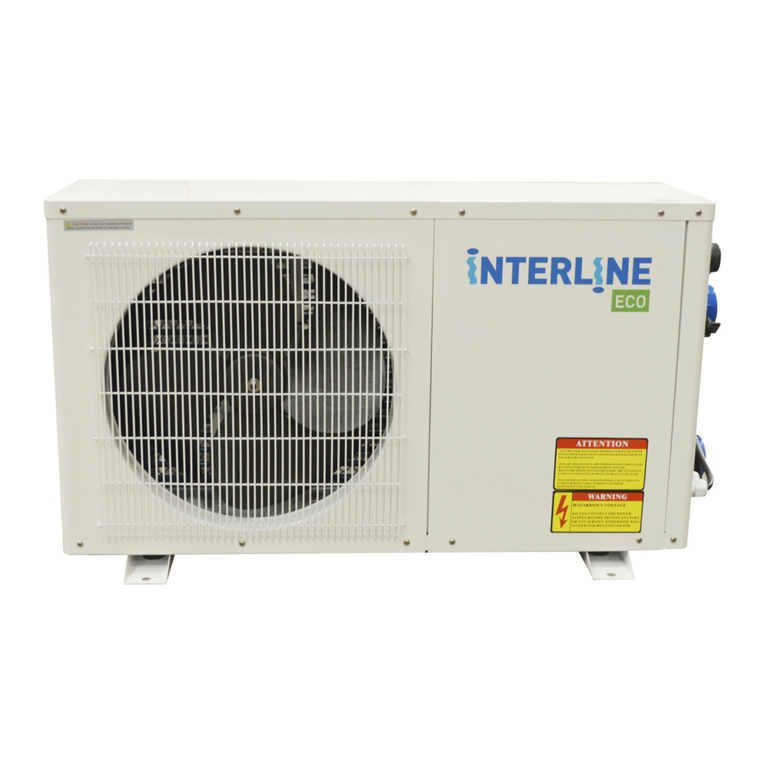
Interline
Interline Eco-3 instruction manual

Sinclair
Sinclair GSH-60IRA series manual

Heat Controller
Heat Controller RSGxxS-1D Series Installation, operation & maintenance manual

Pentair
Pentair INVERTEMP FL Series Installation and operating manual
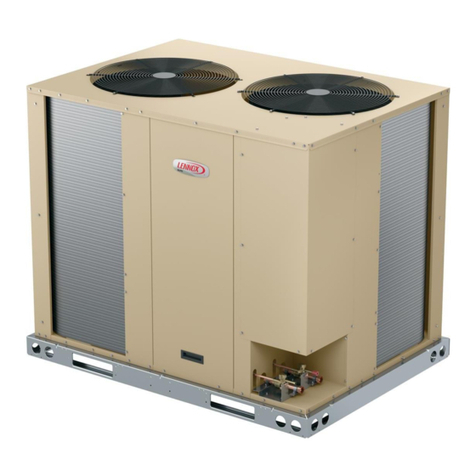
Lennox
Lennox ELP Series user manual

Atlantic
Atlantic 024122 Installation and commissioning instructions
